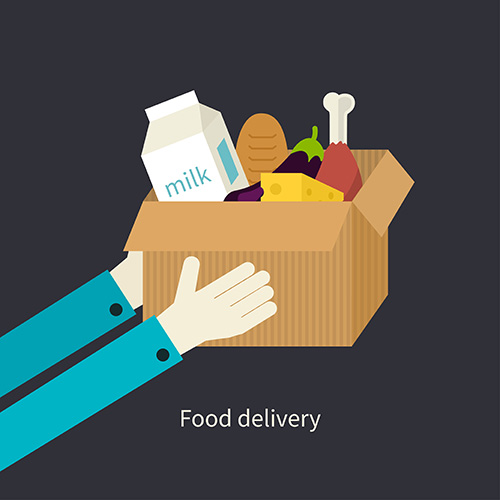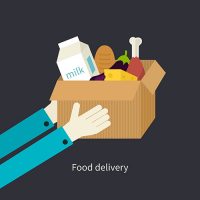As the popularity of home delivery services for food (i.e., online grocery shopping, prepared meals from restaurants, meal kits) continues to gain traction, the industry has been grappling with clear-cut guidance on how to ensure food safety during what is known as the “last mile” of delivery to the consumer. For example, how do third-party delivery services address concerns such as maintaining the right temperature of food during transit? How are allergen risks controlled? Do the people who deliver the food undergo any food safety training?
“It’s kind of a wild west out there,” said Donald Schaffner, Ph.D., professor at Rutgers University during a panel discussion on the topic of home food delivery at the IAFP annual meeting last week in Louisville, Kentucky.
In April, Acting FDA Commissioner Ned Sharpless, M.D. and Deputy Commissioner for Food Policy and Response Frank Yiannas acknowledged that there are food safety challenges presented by “evolving business models” such as e-commerce, and stated that the agency will be looking at ways to work with federal, state and local stakeholders to address the issues. During the IAFP panel, food safety professionals from Amazon, Uber Eats, The Kroger Company and FSIS shed some light on how their respective organizations are handling the food safety risks associated with home delivery.
 Training the People Who Deliver Your Food
Training the People Who Deliver Your Food
The overarching consensus among panelists was that there is not a one-size-fits all approach to training the people who deliver food to the consumer, because there are so many different business models out there. The key to developing successful training will be to first understand the risks associated with each of those different models.
“Everyone needs training, but we don’t want to over-engineering it—not everyone needs ServeSafe training,” said Schaffner. For example, training the person who is simply putting food in the car and delivering it to an address should be different from the training necessary for an employee selecting food in the grocery store versus the warehouse employee packing food. “Figuring out the right-size training and what kind is currently available is one of the things that we’re trying to figure out on the [Conference for Food Protection] committee.” (Note, the Conference for Food Protection committee is developing guidance that addresses home food delivery.) Schaffner indicated that training surrounding time and temperature, allergens and product tampering are important considerations.
Howard Popoola, vice president, corporate food technology and regulatory compliance at The Kroger Company provided the retailer perspective. “Our challenge is multiple in nature,” he said, emphasizing that stores try to keep labor at a minimum. Designing training for workers who are getting a $.25-per-hour raise presents a different hurdle. “What we’re doing in the store today is something we’ve never done before, and [we’re] asking individuals to do things they’ve never done before,” said Popoola. “The training we’ve done before is slowly becoming obsolete.” He said that The Kroger Company is evaluating its current basic food safety training and is looking at building on the segments of its stores that are involved in picking, packing and preparing food—especially the fresh items that are more susceptible to potential microbial contamination.
The Allergen Risk
A question was raised about whether delivery services use the same bags over and over, introducing the potential for cross-contamination. As part of its restaurant community guidelines, UberEats encourages restaurants to put food in tamper-resistant packaging. According to Joseph Navin, senior manager of global safety at the company, in order to reduce the possibility of cross contamination, all food should be placed in a bag before it is put in the insulated bag for transport. UberEats also has guidelines for how those bags should be cleaned. Further addressing the allergen risk: “How do we optimize the way that consumers can disclose that they have a food allergy? We don’t want to have food allergies going in the same free form text [box] that says ‘send extra napkins’,” said Navin. He added that UberEats is developing ways in which dealing with allergens is more conspicuous for restaurants when their employees are preparing food.
Allison Jennings, director food safety and compliance North America at Amazon, said the company has experimented with multiple types of packaging, but there isn’t one perfect set of variables and inputs. Amazon currently uses single-use bags for delivery to mitigate risks with re-cleaning, she said.
Consumer Complaints
As a best practice, integrating relevant information from consumer complaints should become part of a company’s food safety program, said Schaffner. An important role of technology will be its ability to collect feedback that allows companies to generate actionable insights related to food safety, identify any gaps, strengthen controls and be able to develop ways to mitigate risks, said Navin. Amazon currently monitors customer feedback using automatic detection for keywords related to food safety and quality that arrives via the phone, online chats with customer service and social media outlets. When necessary, the method can prompt an investigation, look for trends or help engage in continuous improvement processes. “We are constantly looking for any potential blind spots with our processes,” said Jennings. “We also mystery shop ourselves and make sure we’re meeting our requirements.”
The most common consumer complaints reported among the panelists were not related to food safety, but rather food quality—the product was crushed, didn’t look appealing, etc. “Since we rely on third party partners, we’ve walked through with them on those processes…[and are] challenging our third party partners on who they hire to deliver food, training, etc. and taking caution on delivering food,” said Popoola.
Schaffner said common complaints noted during a study conducted by Rutgers University and Tennessee State University were the following: The product was received out of temperature control; there was evidence of packages leaking (meat, poultry, and fish); a lack of cooking directions; and no mechanism to provide feedback to the company if you have a complaint.
According to Navin, among the top complaints that UberEats receives is missing food or a replacement for items that might be out of stock.
Recalls
In general, recalls in the home delivery segment would apply to products that are received via online grocery shopping services. Since consumers must sign up for these services by providing either an email or phone number, companies can contact customers in the event of a recall. For example, Amazon requires an email account, so it directly emails customers when there is recall or known safety risk associated with a product purchased. Similarly, when a customer uses a loyalty card at a grocery store such as Kroger, the retailer can use its robocall system to notify customers if they purchased an item that is subject to a recall or is associated with an outbreak.




